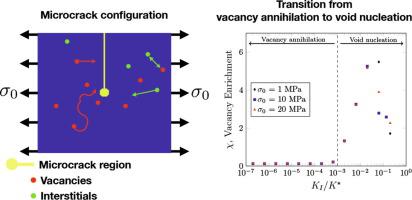International Journal of Solids and Structures ( IF 3.6 ) Pub Date : 2020-12-31 , DOI: 10.1016/j.ijsolstr.2020.12.014 Patrick D. Zarnas , Brad L. Boyce , Jianmin Qu , Rémi Dingreville

|
The accumulation of point defects and defect clusters in materials, as seen in irradiated metals for example, can lead to the formation and growth of voids. Void nucleation is derived from the condensation of supersaturated vacancies and depends strongly on the stress state. It is usually assumed that such stress states can be produced by microstructural defects such dislocations, grain boundaries or triple junctions, however, much less attention has been brought to the formation of voids near microcracks. Here, we investigate the coupling between point-defect diffusion/recombination and concentrated stress fields near mode-I crack tips via a spatially-resolved rate theory approach. A modified chemical potential enables point-defect diffusion to be partially driven by the mechanical fields in the vicinity of the crack tip. Simulations are carried out for microcracks using the Griffith model with increasing stress intensity factor . Our results show that below a threshold for the stress intensity factor, the microcrack acts purely as a microstructural sink, absorbing point defects. Above this threshold, vacancies accumulate at the crack tip. These results suggest that, even in the absence of plastic deformation, voids can form in the vicinity of a microcrack for a given load when the crack’s characteristic length is above a critical length. While in ductile metals, irradiation damage generally causes hardening and corresponding quasi-brittle cleavage, our results show that irradiation conditions can favor void formation near microstructural stressors such as crack tips leading to lower resistance to crack propagation as predicted by traditional failure analysis.
中文翻译:

应力诱导的从微裂纹附近的空位an没到空核的转变
材料中的点缺陷和缺陷簇的积累,例如在辐射金属中,会导致空隙的形成和增长。空隙形核是由于过饱和空位的凝结而产生的,并且在很大程度上取决于应力状态。通常认为,这种应力状态可能是由位错,晶界或三重结等微观结构缺陷产生的,但是,对微裂纹附近空隙形成的关注却很少。在这里,我们通过空间分辨速率理论方法研究了点缺陷扩散/复合与I型裂纹尖端附近集中应力场之间的耦合。修改后的化学势可使点缺陷扩散部分受裂纹尖端附近的机械场驱动。。我们的结果表明,在应力强度因子的阈值以下,微裂纹仅充当微结构的吸收点,吸收点缺陷。高于此阈值,空位会累积在裂纹尖端。这些结果表明,即使在没有塑性变形的情况下,当裂纹的特征长度超过临界长度时,对于给定的载荷,也会在微裂纹附近形成空隙。虽然在韧性金属中,辐照损伤通常会导致硬化和相应的准脆裂,但我们的结果表明,辐照条件可能有利于在微结构应力源(如裂纹尖端)附近形成空隙,从而降低了传统失效分析所预测的裂纹扩展阻力。


























 京公网安备 11010802027423号
京公网安备 11010802027423号